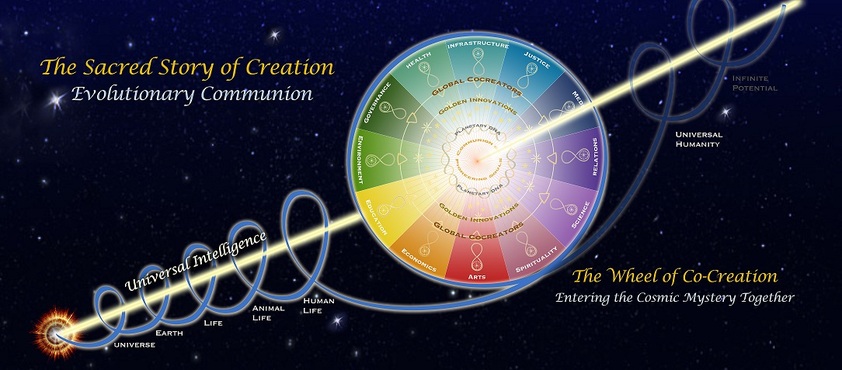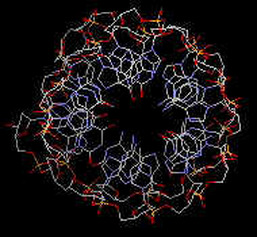A New View of Consciousness and Reality :
Evolution and Consciousness
Evolution and Consciousness
Image courtesy of macangel.com
|
|
Actually, the cilium is far more complex than this, requiring about 200 different kinds of building materials, or proteins that construct the cilium.11 So, the cars, or IFT particles, that carry the proteins must be able to bind to and carry a vast array of different kinds of proteins. Furthermore, all of these parts have to be deposited in just the right location—window parts must be placed at the proper window building position, floor parts must be placed at the floor position, and so on--and at just the right time. Another interesting fact about this process is that the railroad cars, or IFT particles, have two different “motor” proteins, one for powering the cars up the cilium and a different “motor” protein for its trip back down the cilium. Now, here’s the biochemical explanation for how this construction works. Quoting Behe:
“Biochemical studies show that IFT can be conceptually broken down into several parts. The first part consists of the motor proteins that carry the IFT particles along the interior of the cilium. The motor protein that carries the particle toward the tip of the cilium is different from the one that carries it back. The trip out is powered by Kinesin-II, one member of a family of kinesin motor proteins that perform a variety of jobs in the cell . . . The trip back is powered by a dynein motor protein . . . Exactly what causes IFT to shift from kinesin-powered transport to dynein transport at the tip of the cilium remains unknown. The second part of IFT is called the IFT particle. It’s the container that grabs hold of the correct proteins to be carried in or out and releases them at the proper point.” 12 Behe further elucidates that “the IFT particle consists of sixteen separate proteins that bind together in one aggregate.”13 This 16-protein complex can be separated into two protein-complexes, one containing six proteins and the other ten proteins. Each of these structures “contain substructures that are known to be particularly good at binding diverse proteins—exactly what you need to transport the many kinds of protein cargo that travel by IFT along the cilium.”14 Indeed, as mentioned before, the cilium which IFT constructs is made of about 200 different kinds of proteins. Therefore, the IFT particle is a specifically designed protein for its job. It is designed to be able to bind to and carry a variety of different proteins. This system of construction machinery also boasts not one, but two, motor proteins that are designed to carry the IFT particle up and down the interior of the cilium. If that’s not enough, when building this system, there is some sensing mechanism that senses the amount of material that the cilium needs, evidenced by the fact that “after construction is completed the trains keep coming at about the same rate, but now some of the cars are empty.”15 You can imagine the sophisticated control mechanisms that must go into the construction project, with genes controlling how much of each protein to build and when to build them, how many IFT particles to send with loads of protein, and when to cut production. Furthermore, all of the proteins used in construction require acute specification. The IFT particles must be precisely engineered to be able to bind to all of the differently shaped proteins that make up the cilium, the motor proteins must be precisely engineered to function as motors to move the IFT particles up and down the length of the cilium, and each protein that goes into the actual building of the cilium requires precise engineering to fit with all of the other parts and create a functional cilium. As you can tell, this process is integrated, complex, and coherent. Furthermore, DNA provides the instruction manual for building the entire structure, including instructions for building the molecular machines used to construct the edifice, instructions for building each of the around 200 proteins that compose the building blocks of the structure, and control instructions for co-ordinating the entire process. It should be blatantly obvious by now that an intelligence is behind this process. You don’t randomly throw together a skyscraper. It takes careful planning; blueprints of the building must be drawn up, resources gathered together at the building site, all of the construction workers given specific assignments, and foremen and supervisors to manage the entire process. A cellular machine requires just as much. In the case of the cilium, DNA contains the blueprints for making the building, as well as the information needed to co-ordinate the project, make the IFT particles (construction workers) to do the work, and make all the building materials. The cell is miraculous in that it has the ability to make both the work force (construction machinery) and all of the materials needed to make up the structure (essentially many different kinds of proteins). Stephen Meyer’s concept of specified information is also relevant here. In IFT, we have a specific arrangement of parts that perform a specific function. This is evident in the building process and in the completed structure. Again, this requires an intelligence to arrange the parts into a functional pattern. It is useless to invoke a Darwinian, stepwise scenario, for this process. That is because the process is so integrated. Without an IFT particle, there could be no cilium. Without the control instructions for co-ordinating the construction project you would have a mess of unregulated IFT particles, carrying unregulated proteins, at unregulated times. The project would never be able to build a coherent machine. And if you are missing many of the around 200 proteins needed for building the cilium, well, you can’t build it. Complex integration is the key to understanding intelligent design. Gradual evolution doesn’t work because without any one of the parts, the others couldn’t function. Therefore, a bottom-up approach doesn’t work. Instead, a top-down approach whereby the end product (cilium) is thought up first, or envisioned in the mental realm, then the many details of how to build that product are worked out in succession, and finally the whole system is implemented at once. Intelligent agents do this all the time. We think of a new idea, say to build the first automobile. First, we must think about what function our new structure is to have. In our example of the automobile, the function is to move people and objects quickly from one place to another via roads. Then, we should consider what parts are needed and how they will connect to perform the desired function. For instance, a car would need wheels that turn, a motor to power the car, a steering wheel to steer the car, and so on… We would have to figure out how to connect all of these parts to produce a functional automobile. Once we have the entire plan with all the parts and how to connect them in our minds (the mental realm), we can then begin to manufacture and arrange the material constituents to conform to our mental image and create the world’s first automobile. So, we start with figuring out what function we want a new machine to perform. Then we have to think of a design that will enable that function to be performed. The design requires not only the parts that will be used, but how those parts will connect. Once we have this mental image, we can go to work building our new structure. In essence, we take ideas from a mental, non-material realm, and then manifest those ideas in the material realm. This is simply an imitation of what a greater intelligent consciousness does to create the machinery that sustains life. How else are we to explain intelligent workings at the cellular level without an intelligence that penetrates into the deepest aspects of the material world? And where else do we find intelligence than in the workings of conscious agents? Different types of cells require different functions, which require different kinds of protein machinery, which in turn requires the guidance of an intelligence to form. From DNA on up, life is intricately designed. So, all of creation is first envisioned in the mental realm. To implement these creations in the material realm requires a conscious intelligent entity to arrange and organize matter in conformance with the desired function and design. For life to show evidence of intelligent design, consciousness must underlie material process and have the ability to form and manipulate the material world. To take a line from Physicist David Bohm, it forms and in-forms the material world.16 It is the basis and mover of all energy in the universe. This underlying consciousness not only forms all of the matter in the universe, it also provides the information to organize matter into functional systems, such as DNA and living cells. As we will see after looking at the evidence for consciousness after death, this consciousness has its source in a realm outside of our known concepts of space and time. It is a realm of infinite energy in a non-local space. Our consciousness is in fact identical to this One Source Consciousness. Now we turn to the unassailable evidence for life after death. Next: Life After Death: The Verdict Is In |

